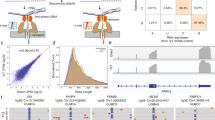Abstract
Pseudouridine, a modified RNA residue formed by the isomerization of its parental U nucleotide, is prevalent in a majority of cellular RNAs; its presence was reported in tRNA, rRNA, and sn/snoRNA as well as in mRNA/lncRNA. Multiple analytical deep sequencing-based approaches have been proposed for pseudouridine detection and quantification, among which the most popular relies on the use of soluble carbodiimide (termed CMCT). Recently, we developed an alternative protocol for pseudouridine mapping and quantification. The principle is based on protection of pseudouridine against random RNA cleavage by hydrazine/aniline treatment (HydraPsiSeq protocol). This “negative” detection mode requires higher sequencing depth and provides a precise quantification of the pseudouridine content. All “wet-lab” technical details of the HydraPsiSeq protocol have been described in recent publications. Here, we describe all bioinformatics analysis steps required for data processing from raw reads to the pseudouridylation profile of known or unknown RNA.
Access this chapter
Tax calculation will be finalised at checkout
Purchases are for personal use only
Similar content being viewed by others
References
Adachi H, De Zoysa MD, Yu Y-T (2019) Post-transcriptional pseudouridylation in mRNA as well as in some major types of noncoding RNAs. Biochim Biophys Acta Gene Regul Mech 1862(3):230–239. https://doi.org/10.1016/j.bbagrm.2018.11.002
McCown PJ, Ruszkowska A, Kunkler CN et al (2020) Naturally occurring modified ribonucleosides. Wiley Interdiscip Rev RNA 11(5):e1595. https://doi.org/10.1002/wrna.1595
Borchardt EK, Martinez NM, Gilbert WV (2020) Regulation and function of RNA pseudouridylation in human cells. Annu Rev Genet 54:309–336. https://doi.org/10.1146/annurev-genet-112618-043830
Morais P, Adachi H, Yu Y-T (2021) Spliceosomal snRNA epitranscriptomics. Front Genet 12:652129. https://doi.org/10.3389/fgene.2021.652129
Spenkuch F, Motorin Y, Helm M (2014) Pseudouridine: still mysterious, but never a fake (uridine)! RNA Biol 11(12):1540–1554. https://doi.org/10.4161/15476286.2014.992278
Motorin Y, Marchand V (2021) Analysis of RNA modifications by second- and third-generation deep sequencing: 2020 update. Genes 12(2):278. https://doi.org/10.3390/genes12020278
Westhof E (2019) Pseudouridines or how to draw on weak energy differences. Biochem Biophys Res Commun 520(4):702–704. https://doi.org/10.1016/j.bbrc.2019.10.009
Adachi H, DeZoysa MD, Yu Y-T (2019) Detection and quantification of pseudouridine in RNA. Methods Mol Biol Clifton NJ 1870:219–235. https://doi.org/10.1007/978-1-4939-8808-2_17
Zhou KI, Clark WC, Pan DW, Eckwahl MJ, Dai Q, Pan T (2018) Pseudouridines have context-dependent mutation and stop rates in high-throughput sequencing. RNA Biol 15(7):892–900. https://doi.org/10.1080/15476286.2018.1462654
Durairaj A, Limbach PA (2008) Mass spectrometry of the fifth nucleoside: a review of the identification of pseudouridine in nucleic acids. Anal Chim Acta 623(2):117–125. https://doi.org/10.1016/j.aca.2008.06.027
Addepalli B, Limbach PA (2011) Mass spectrometry-based quantification of pseudouridine in RNA. J Am Soc Mass Spectrom 22(8):1363–1372. https://doi.org/10.1007/s13361-011-0137-5
Patteson KG, Rodicio LP, Limbach PA (2001) Identification of the mass-silent post-transcriptionally modified nucleoside pseudouridine in RNA by matrix-assisted laser desorption/ionization mass spectrometry. Nucleic Acids Res 29(10):E49–E49. https://doi.org/10.1093/nar/29.10.e49
Helm M, Schmidt-Dengler MC, Weber M, Motorin Y (2021) General principles for the detection of modified nucleotides in RNA by specific reagents. Adv Biol 5(10):e2100866. https://doi.org/10.1002/adbi.202100866
Chang SE, Ish-Horowicz D (1974) Selective modification of cytidine, uridine, guanosine and pseudouridine residues in Escherichia coli leucine transfer ribonucleic acid. J Mol Biol 84(3):375–388. https://doi.org/10.1016/0022-2836(74)90446-x
Ofengand J, Del Campo M, Kaya Y (2001) Mapping pseudouridines in RNA molecules. Methods (San Diego Calif) 25(3):365–373. https://doi.org/10.1006/meth.2001.1249
Carlile TM, Rojas-Duran MF, Zinshteyn B, Shin H, Bartoli KM, Gilbert WV (2014) Pseudouridine profiling reveals regulated mRNA pseudouridylation in yeast and human cells. Nature 515(7525):143–146. https://doi.org/10.1038/nature13802
Lovejoy AF, Riordan DP, Brown PO (2014) Transcriptome-wide mapping of pseudouridines: pseudouridine synthases modify specific mRNAs in S. cerevisiae. PLoS One 9(10):e110799. https://doi.org/10.1371/journal.pone.0110799
Schwartz S, Bernstein DA, Mumbach MR et al (2014) Transcriptome-wide mapping reveals widespread dynamic-regulated pseudouridylation of ncRNA and mRNA. Cell 159(1):148–162. https://doi.org/10.1016/j.cell.2014.08.028
Sas-Chen A, Nir R, Schwartz S (2021) mito-Ψ-Seq: a high-throughput method for systematic mapping of Pseudouridine within mitochondrial RNA. Methods Mol Biol Clifton NJ 2192:103–115. https://doi.org/10.1007/978-1-0716-0834-0_9
Zhang W, Eckwahl MJ, Zhou KI, Pan T (2019) Sensitive and quantitative probing of pseudouridine modification in mRNA and long noncoding RNA. RNA 25(9):1218–1225. https://doi.org/10.1261/rna.072124.119
Bakin A, Ofengand J (1993) Four newly located pseudouridylate residues in Escherichia coli 23S ribosomal RNA are all at the peptidyltransferase center: analysis by the application of a new sequencing technique. Biochemistry 32(37):9754–9762
Massenet S, Motorin Y, Lafontaine DL, Hurt EC, Grosjean H, Branlant C (1999) Pseudouridine mapping in the Saccharomyces cerevisiae spliceosomal U small nuclear RNAs (snRNAs) reveals that pseudouridine synthase pus1p exhibits a dual substrate specificity for U2 snRNA and tRNA. Mol Cell Biol 19(3):2142–2154
Marchand V, Pichot F, Neybecker P et al (2020) HydraPsiSeq: a method for systematic and quantitative mapping of pseudouridines in RNA. Nucleic Acids Res 48(19):e110. https://doi.org/10.1093/nar/gkaa769
Marchand V, Bourguignon-Igel V, Helm M, Motorin Y (2021) Analysis of pseudouridines and other RNA modifications using HydraPsiSeq protocol. Methods (San Diego Calif) 203:383–391. https://doi.org/10.1016/j.ymeth.2021.08.008
Birkedal U, Christensen-Dalsgaard M, Krogh N, Sabarinathan R, Gorodkin J, Nielsen H (2015) Profiling of ribose methylations in RNA by high-throughput sequencing. Angew Chem Int Ed Engl 54(2):451–455. https://doi.org/10.1002/anie.201408362
Pichot F, Marchand V, Ayadi L, Bourguignon-Igel V, Helm M, Motorin Y (2020) Holistic optimization of Bioinformatic analysis pipeline for detection and quantification of 2′-O-methylations in RNA by RiboMethSeq. Front Genet 11:38. https://doi.org/10.3389/fgene.2020.00038
Marchand V, Blanloeil-Oillo F, Helm M, Motorin Y (2016) Illumina-based RiboMethSeq approach for mapping of 2′-O-Me residues in RNA. Nucleic Acids Res 44(16):e135. https://doi.org/10.1093/nar/gkw547
Helm M, Motorin Y (2017) Detecting RNA modifications in the epitranscriptome: predict and validate. Nat Rev Genet 18(5):275–291. https://doi.org/10.1038/nrg.2016.169
Acknowledgments
This work was supported by ANR grants (MetRibo, D-erase) and Région Grand Est FRCR grants (EpiARN, ViroMOD) to the V.M./Y.M., and Deutsche Forschungsgemeinschaft (DFG) grants to M.H. [HE3397/17-1, SPP1784, and TRR319 RMaP, TP C01].
Author information
Authors and Affiliations
Corresponding author
Editor information
Editors and Affiliations
Rights and permissions
Copyright information
© 2023 The Author(s), under exclusive license to Springer Science+Business Media, LLC, part of Springer Nature
About this protocol
Cite this protocol
Pichot, F., Marchand, V., Helm, M., Motorin, Y. (2023). Data Analysis Pipeline for Detection and Quantification of Pseudouridine (ψ) in RNA by HydraPsiSeq. In: Oliveira, P.H. (eds) Computational Epigenomics and Epitranscriptomics. Methods in Molecular Biology, vol 2624. Humana, New York, NY. https://doi.org/10.1007/978-1-0716-2962-8_14
Download citation
DOI: https://doi.org/10.1007/978-1-0716-2962-8_14
Published:
Publisher Name: Humana, New York, NY
Print ISBN: 978-1-0716-2961-1
Online ISBN: 978-1-0716-2962-8
eBook Packages: Springer Protocols




